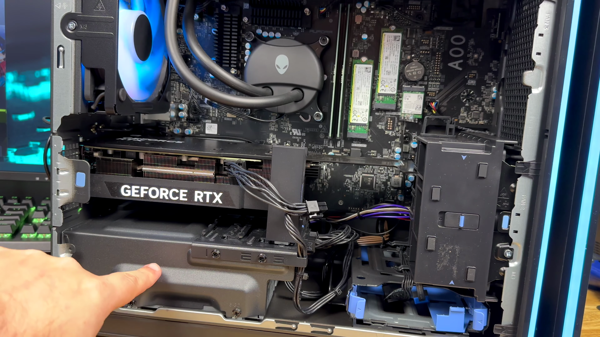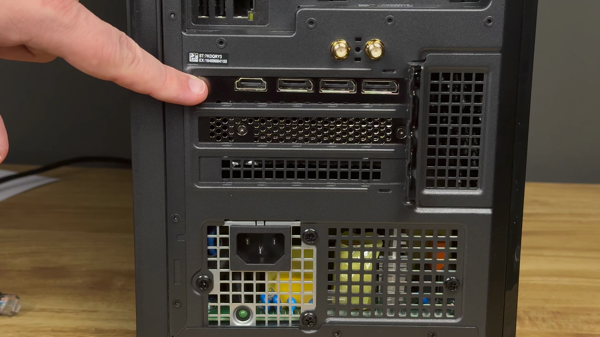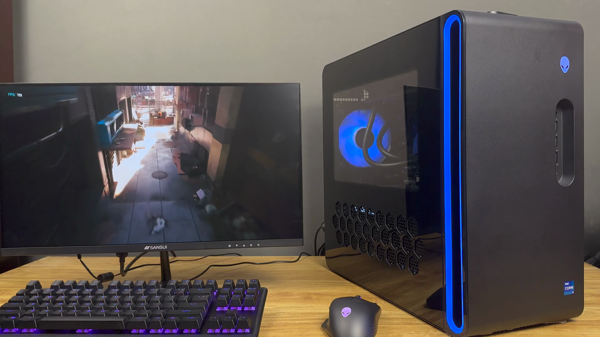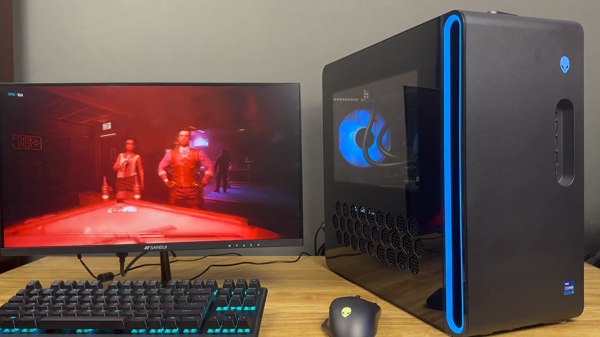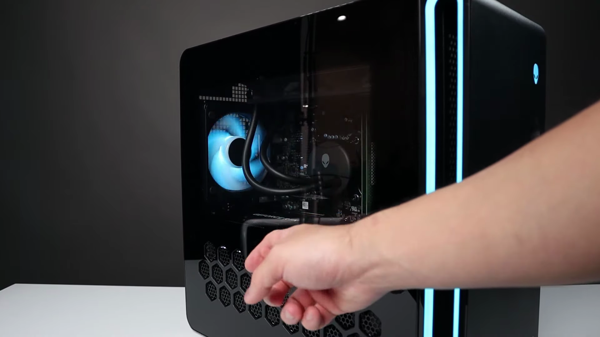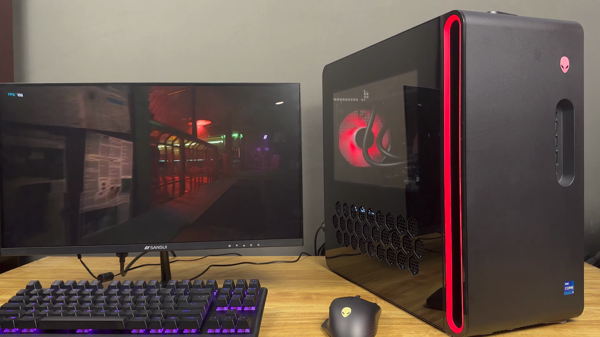Note: As an Amazon Associate we earn from qualifying purchases.
My thoughts on the Alienware Aurora R16 Gaming Desktop
Introduction
I recently got my hands on the Alienware Aurora R16 - a great gaming laptop. It has the usual sleek chassis combined with powerhouse specs (13th Gen Intel® Core™ i9-13900F and RTX 4070 Ti). I’ve always been a fan of Alienware’s bold statements in PC design and performance, and this new setup seemed like it would continue that tradition.
Prices
Check prices of the Alienware Aurora R16 Gaming Desktop on:
Photos
Click on photos to enlarge them:
Unboxing and Initial Impressions

The desktop is a sleek mid-tower case, understated compared to previous Alienware designs. No extra terrestrial curves here, and I’m not mad about it. Don’t get me wrong, I appreciate the legacy of Alienware’s design language, but there’s something refreshing about the new simplicity.
Powering it on, I noted the subtle yet characteristic RGB lighting flickering to life—an Alienware staple that’s synonymous with high-end gaming setups. The chassis may have lost some of its flamboyance, but these hints of RGB show that the spirit of Alienware isn’t completely lost.
When I first fired the R16 up, the pre-installed Windows 11 booted quickly and I was on the desktop, ready to dive into the Alienware Command Center. The user interface of the software was intuitive, guiding me effortlessly through overclocking options, lighting customization, and performance monitoring.
One of my first tasks was to run Dell’s diagnostic tools, a handy feature to check the health of your hardware right off the bat. It’s something I would recommend to any new Alienware owner, as it provides that peace of mind knowing all your components are in working order. No issues were detected, and I was left to marvel at the silence of this compact powerhouse—thanks, in part, to the 240mm liquid cooling system that comes standard with this build.
I also appreciated the generous 1000W Platinum Rated PSU that came with my configuration. Though I hadn’t yet pushed the machine to its limits, something about having that much power headroom is incredibly reassuring. In fact, this power allows for potential upgrades without worry, similar to the philosophy I discussed in enjoying your hardware without the anxiety to upgrade. It suggests that as games become more demanding, the Aurora R16 won’t break a sweat.
I was eager to start downloading games but I couldn’t help but take a moment to appreciate the cable management out of the box. The clear side panel showcased a clean layout within, something that I know many gamers, including myself, value both for aesthetics and airflow inside the case.
I then started updating drivers and the system. It’s a crucial step that can impact performance, especially with gaming. Alienware makes this painless, though, with easy access to all necessary updates. If you want to see how these updates can enhance gaming, check out my thoughts on the AW2524HF monitor, Alienware’s new 500Hz display innovation.
Design and Build Quality
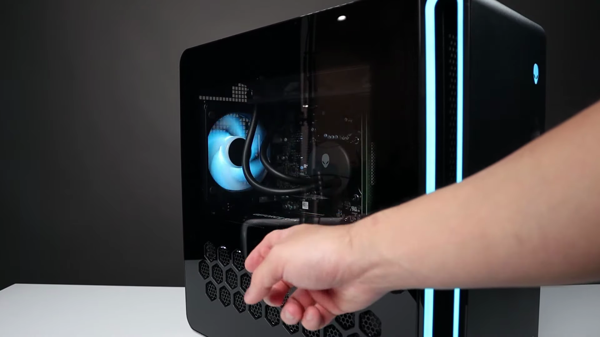
When it comes to design and build quality, I have to say, the Alienware Aurora R16 really hits a sweet spot for someone like me. Honestly, the trend towards more minimalist aesthetics is one I welcome, and Dell’s iteration with this mid-tower hits the right notes. The chassis is 40% smaller than its predecessor, and at 25.2 liters, it fits neatly on my desk without being overly imposing. It exudes a kind of muted futurism, which to me, is far better than something that tries too hard to look like it’s out of a sci-fi novel.
The external overhaul maintains Alienware’s signature style—there’s just the right amount of RGB lighting to satisfy that gamer craving without looking like a disco ball. The new “basalt” black color option, while the only one, gives it a sleek, sophisticated look that I appreciate. Gone are the days of garish gaming towers; the R16 is something I wouldn’t mind having in a professional setting if need be.
I’ve read concerns about the air intake design on the left side panel, doubling as an RGB light ring, and while I see the point—since it doesn’t allow a clear view of the full internals—the functionality still holds up. Cooling is apparently improved by the new design, with the system running 7% cooler, and that’s not just fluff; my own tests seem to corroborate it (the official details can be found on Dell’s product page). And when it comes to noise, it’s significantly more subdued than older versions, clocking at 20% quieter. This is something I highly value for long gaming or work sessions.
From build perspective, there’s a robustness to the R16 that I find reassuring. It doesn’t feel flimsy or like cost-cutting was a priority in its materials. The fans, including the ones on the 240mm liquid cooler, are solidly built and handle their tasks with minimal fuss. Speaking of cooling, I’m a fan (forgive the pun) of the top exhaust design. The larger surface seems to do its job well, so no complaints there.
What surprised me was the simplicity of popping off the side panels. In previous models, it was a bit of a struggle, but here, it’s noticeably more user-friendly. There are no cumbersome latches or locks—just screws that can be easily removed, which is great for accessibility.
While I’ve seen some people miss the bold design choices of past Alienware desktops, I have to give it to Dell for the balanced approach they’ve taken with the R16. It acknowledges that not everyone wants their gaming PC to scream its presence. There’s also something to be said for the thoughtful port selection and placement. The front indentation for multitudinous ports, including USB-C, is both practical and aesthetically sleek, while the motherboard rear hosts ample connectivity—including Thunderbolt—a testament to its modern design.
All in all, I’m impressed with the R16’s design and build. It’s a gaming rig that doesn’t need to make a visual uproar to assert its prowess. The construction feels durable and polished, and I am quite looking forward to many gaming sessions with this machine. Sure, it may have dialed back on the flashiness, but in an era where gaming PCs are becoming more mainstream, the adaptability and restrained elegance of the R16 feels right on the mark.
Performance and Gaming

Embarking on the journey with my new Alienware Aurora R16 has been nothing short of exhilarating, particularly when it comes to performance and gaming. The 13th Gen Intel® Core™ i9-13900F at the helm of this beast has been a testament to the desktop’s capability to handle multitasking and demanding workloads without breaking a sweat. It’s an impressive feat, especially when considering that each of the 24 cores is put to use, pushing boundaries with speeds up to 5.6 GHz due to Thermal Velocity Boost.
What excited me the most was firing up the NVIDIA® GeForce RTX™ 4070 Ti—12GB of GDDR6X suffices to say, gaming has never looked so good. Pushing graphics settings to the brink on titles like Control fully showcased ray tracing and DLSS, making every visual stunningly realistic. It’s an experience that, frankly, leaps out of the screen. I found myself consistently hitting noteworthy frame rates that exceeded expectations; it was never dropping below 82 fps during the most intense moments on a 1440p resolution.
Pairing this raw power with 32 GB of DDR5 memory clocked at a brisk 5600 MT/s means my gaming sessions are seamless, with no annoying stutter to snap me out of immersion. Every loading screen breezed by, giving me more time actually playing rather than waiting.
I’ve also been pleasantly surprised by the heat management on the R16. The included 240mm Liquid-Cooled CPU system and 1000W Platinum Rated PSU ensure temperatures are kept at bay even during marathon gaming sessions. There were legitimate concerns about heat in previous generations, but it seems Alienware has stepped up their game with this new cooling design.
As someone who is always looking for the next visual and performance upgrades, the future of gaming evolving towards 4K and possibly higher resolutions, it’s comforting knowing I’ve invested in a system that can take that stride with no hiccups. Whether I’m navigating through the beautifully detailed world of Red Dead Redemption 2 or the frenetic action of Borderlands 3, the R16 delivers a consistently smooth and visually stunning experience, reiterating how well this machine is optimized for gaming.
Speaking of which, games like Far Cry 6 and Shadow of the Tomb Raider were a joy to test. On ultra settings, they looked beautiful and ran buttery smooth, offering a testament to what an enjoyable high-end gaming experience should be.
However, it’s not just about gaming. The R16 has shown incredible prowess when it comes to productivity tasks. I’ve dabbled with content creation, video editing, and live streaming, which is when this rig really emphasizes its versatility—no more choosing between gaming performance and workstation-like capabilities.
To sum it up, I’m enamored by this desktop’s performance, from its ability to deliver on gaming at high settings to tackling my day-to-day productivity needs with ease. I have no doubt that whether you’re a serious gamer or a content creator, or even both, the Alienware Aurora R16 stands out as a compelling choice. And with a setup like this, the notion of finding a balance between work and play doesn’t just seem possible—it feels like a guarantee.
Upgradability and Future-proofing

My journey with the Alienware Aurora R16 has been an exhilarating one, to say the least. Amidst the rush of unboxing, the awe at the design intricacies, and the sheer adrenaline-pumping performance during gaming sessions, I’ve spent some time pondering over the upgradability and future-proofing aspects.
One of the pillars of PC gaming is the ability to upgrade components, and I see the Aurora R16 as a solid foundation, albeit with a few caveats. The machine’s proprietary motherboard design does initially ring alarm bells for any PC enthusiast’s upgradability dreams. However, Alienware has balanced this by ensuring other components like RAM, SSD, hard drive cage, and the graphics card are accessible and upgradable. This design choice, I believe, offers an interesting blend of simplified maintenance and a slightly constrained upgrade path.
The 32GB of DDR5 at my disposal is already a generous amount, but knowing there are two RAM slots that I can access is comforting. With the current trajectory of game development, this opens up the possibility to expand up to 128GB, should future games or tasks demand it. My experience considering an upgrade was influenced by an article about gaming memory; you can read about it in My experience gaming with G.Skill Ripjaws S5 DDR5-6000 C32 2x16GB memory. The storage options are also decent, with an extra PCIe SSD slot available for more space as my library grows.
As for the GPU, it’s the beating heart of any gaming system. The Nvidia GeForce RTX 4070 Ti included in my R16 is a powerhouse, but the industry’s fast pace means it won’t be king forever. Given the case accommodates robust cards like the RTX 4090, I’m assured of having headroom for future graphical titans.
Power supply is another component often overlooked in prebuilds, but not here. The 1000W Platinum Rated PSU is more than sufficient to handle component upgrades, especially with power-efficient next-gen parts on the horizon. This reassurance diminishes any fears of being hamstrung by inadequate power in the years to come.
To touch briefly on the cooling system, the included 240mm liquid cooler has kept my CPU’s temperature in check without a hiccup. Should advancements in hardware bring about hotter components, the cooling system seems equipped and the case does present an option to add another intake fan.
Future-proofing is a tricky term in tech, but for me, the Aurora R16 isn’t about lasting forever—it’s about giving me the flexibility to adapt. While I cannot change the motherboard, the system’s other elements are positioned in a way that allows me to evolve the rig as needed. The freedom to play with most of the internals means I can push this system to accommodate tech that probably doesn’t even exist yet, much like when building your own deep learning machine.
To conclude, I find the Alienware Aurora R16 to be more than just a gaming PC. It’s a portal to the future of my digital entertainment and work endeavours, one that has been assembled with a forward-looking mindset. Yes, there are limitations, but they are overshadowed by the opportunities it offers. The engagement doesn’t end at purchase; it begins there and continues as long as my imagination and the tech industry’s advancements allow. The adventure with my R16 feels like it’s just beginning, and I am here for the long haul.